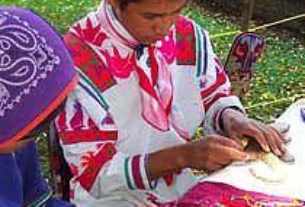The Sierra Madre! The very name conjures up images of movie sets, mine shafts and majestic, rugged mountains, perhaps with cowboys riding through. Nowhere in Mexico is it quite so easy to experience and savor the reality behind these derived images as on the drive from Mazatlan to Durango along Highway 40.
Just 24 kilometers south of Mazatlan, Highway 40 begins its eventually tortuous route innocently enough as it climbs gently through Concordia, with its old church and colonial-style furniture factories and, at kilometer 54, winds past the entrance to the village of Copala.
TOURISM COMES TO COPALA
If you haven’t yet been to Copala, then go soon, since its quiet charm, with romantically meandering streets of white walled houses with their characteristic red-tiled roofs, cannot last for ever. An ancient mining settlement with one of the oldest churches in the area, one of the few examples of Baroque architecture anywhere in Sinaloa (though not the only example as fond locals like to claim!), its plaza has an untidy appeal about it with a small wrought-iron bandstand in the centre and timber supported portales on several sides. The village’s unlikely mix of elegant and simple dwellings reflects a growing influx of non-Mexicans seeking the quiet life without telephones and, until relatively recently, without electricity either.
The mines had been worked out, or so they said, and the people mostly drifted away, in search of jobs, to Mazatlan or California. But now the village has been rejuvenated, the mine reopened. Two good restaurants, Daniel’s and The Copala Butter Company, and a cheap, unpretentious, and tastefully furnished hotel, the Posada San Jose, cater to the tastes of the hundreds of tourists who explore the village each year.
Most come from Mazatlan for the day only, brought by regular tour companies from the large hotels, accompanied by guides and pausing only to enjoy a Mexican ‘comida’ before viewing an enterprisingly staged ‘burro’ race and returning to the coast in time for supper. Some, those with more time, stay overnight seeking a tranquility and serenity while surrounded by beauty, hard to find and in increasingly short supply any where in the modern world.
The next village along the highway, La Capilla del Taxtle, also houses a good hotel, the Villa Blanca, which provides a popular weekend respite from the coastal heat in summer. This German-run establishment has a friendly and welcoming atmosphere and serves excellent food including German specialities. Their reasonable rates include three meals (all the food and drink you can consume!). This hotel is one of those favoured by bird-watching groups, situated, as it is, on the edge of the pine forests which clad the higher slopes.
GLIMPSES OF THE SIERRA
But visitors seeing the countryside around La Capilla del Taxtle and Copala, hearing their guides tell of the wonders of the Sierra Madre, must come away a little disappointed, thinking only that their personal memories and images have become somewhat distorted with time, somehow harsher than the reality.
Can these innocuous-looking rolling hills, partially forested, partially cultivated, really be the Sierra Madre? The answer lies only a few short kilometres further along this same road, just across the Tropic of Cancer.
SPECTACULAR SCENERY
Along this next stretch of road, climbing and winding ever upwards the true nature of the Sierra Madre suddenly reveals itself. The slopes become precipitous, the views apparently endless, the clouds ever closer. Indeed, it is not uncommon to look to the side and realise with a start that the clouds are actually for below!
This is the Sierra Madre, grand and imposing, and until the completion of this road, a daunting and virtually uncrossable barrier separating the coast from the rest of Mexico. Even now, the meandering black strip of asphalt, cut deep into the green hillside, and perched on the edge of the deep ‘barranca’, is like an unwelcome intruder in the landscape.
Soon, the most awe-inspiring section of all is reached. Called the Devil’s Backbone, it is a nine kilometre gravity defying section of road which unites two arms of the Sierra Madre, seemingly over the top of the rest of the world. This stretch affords views to both sides over a vast area of magnificent, unimaginably wild, scenery. Then, after one or two delightful picnic sites next to unusual rocky outliers are revealed, the road reaches La Ciudad.
Despite its name, La Ciudad is hardly a city, but rather a somewhat ugly timber town with corrugated iron roofs, the first settlement of any size in Durango State, and the point at which you must remember to put your watch forward one hour.
The next town, El Salto, is no prettier but is the entrance to the Angel’s Gateway State Park, a virgin area of wilderness ideal for camping and hunting expeditions into the virtually uninhabited Durango side of the Sierra Madre.
A little further down the road are various sites which have rustic cabins for rent, the first decent accommodations for almost two hundred kilometres. They include the Sierra Paradise, about 80 kilometres from Durango City and the El Tecuan State Park, slightly closer.
MOVIE SETS
The scenery around here was used as the backdrop for several movies but to get an even better idea of Durango’s Movielands, try driving the first few kilometres of Highway 45, north from Durango City, the state capital (full range of tourist services), towards Hidalgo de Parral. This road first passes the tropically cowboy Villa del Oeste (Western Village) and then Chupaderos where an entire village street movie set was constructed around an existing, ancient chapel.
The Sierra Madre of Highway 40 with its villages, film sets, scenery and mines, not only matches the images created by ‘Treasure of the Sierra Madre’ and countless other movies, but surpasses them in every respect. For your next excursion out from Mazatlan, head east but remember that, while Copala may be the best place to stay, the real ‘Treasure of the Sierra Madre’, still waiting to be discovered, lies beyond.

